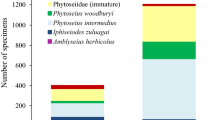Abstract
This study investigated the occurrence and diversity of hemi-parasitic plants, vertebrate and insect pest species of Parkia biglobosa (Keay), and Vitellaria paradoxa (Gaertn.) as well as the strategies for their control in the parklands of the Nigerian humid savanna. Results indicated that of the two major hemi-parasitic plants encountered, Tapinanthus globiferus was the more widespread with wider host range than T. dodonifolius. Mechanical control by cutback of infested branches was ineffective for both species. The major vertebrate pests consist of 6 avian species from 3 families: Nectaridae, Plocidae and Cuculidae; a fruit bat, Epomops frangueti and an unidentified squirrel. The species fed on both the fruits of the trees and the seeds of the hemi-parasitic plants. Twenty insect species from 14 families were encountered on P. biglobosa compared to 33 species from 17 families on V. paradoxa in all the ecological zones covered in the study. Species diversity was comparatively higher in the fallow than in the cultivated land. The majority of the insects encountered was of little significance and may not warrant application of control. Cirina forda (Saturnidae:lepidoptera) was a major pest causing 60%–90% defoliation of mature trees of V. paradoxa. All larval stages were destructive but control at this stage is not advised because it provides incidental source of food to locals. Control after pupation using a slow-release insecticide with a soil penetration depth of 15–20 cm is suggested.
Similar content being viewed by others
References
Awodoyin R.O., Delaja B.A. and Denton O.A. 1997. Vitellaria paradoxa in the farming systems of the Nigeria humid savanna. Proceedings of the Forestry Association of Nigeria pp. 226–233.
Basset O. 1999. Diversity and abundance of insect herbivores foraging on seedlings in a rainforest in Guyana. Ecological Entomology 24: 245–259.
Bright E.O., Misari S.M. and Ogunyemi S. 2001. Preliminary study on the host range and dispersal of mistletoe, Tapinanthus globiferus. Nigerian Journal of Weed Science 14: 53–58.
Clark D.B. and Clark D.A. 1985. Seedling dynamics of a tropical tree: Impacts of herbivory and meristem damage. Ecology 66: 1884–1892.
De la Cruize M. and Dirzo R. 1987. A survey of the standing levels of herbivory in seedlings from a Mexican rainforest. Biotropica 19: 98–106.
Egunjobi J.K. 1991. Ecology and food production In: Ogunyemi, S (Ed.) Ecology and sustainable development. Proceedings of the of Ecological society of Nigeria Spurgeon, 1980.
Folgarait P.J., Marquis R.J., Ingvarsson P., Braker E.R. and Arguendas M. 1995. Patterns of attack by insect herbivores and a fungus on saplings in a tropical tree plantation. Environmental Entomology 10: 159–169.
Franklin W.M. and Ruberte R.M. 1975. Edible leaves of the tropics. Antillean College Press: Mayaguez, Puerto Rico 235 pp.
Janzen D.H. 1970. Herbivores and the number of tree species in tropical forests. American Naturalist 104: 501–528.
Odebiyi, J.A., Bada S.O., Omoloye, A.A., Oni, P.I. and Awodoyin R.O. 2002. Spatial distributions, pupation behaviour and natural enemies of Cirina forda Westwood (Lepidoptera: Saturniidae) in soil around its host sheanut tree, Vitellaria paradoxa in Northern Nigeria. Insect Science and its Application (in press).
Odebiyi J.A., Bada, S.O., Oni, P.I., Omoloye A.A. and Awodoyin R.O. 2001. Task 2.2: improvement on the performance and Vitellaria paradoxa and Parkia biglobosa. In: Improved management of agroforestry parkland systems in sub-Saharan Africa. Third Annual Report of the European Union financed-INCO-DC: International Co-operation with Developing Countries 1994-2000. Contract number: ERBIC18-CT98-0261 pp. 121–126 (homepage: http://www.safs.bangor.ac.uk/parklands).
Omolaja S.S. and Famaye A.O. 2001. The incidence of mistletoe on coffee in Nigeria. Bioscience Communicatios 13 (1).
Phillips E.J. 1977. Mistletoes on cocoa in Ghana. Ghana Journal of Agric. Sc. 10: 137–143.
Springate N.D. and Basset Y. 1996. Diet activity of arboreal arthropods associated with Papua New Guinea trees. Journal of Natural History 30: 101–112.
Author information
Authors and Affiliations
Rights and permissions
About this article
Cite this article
Odebiyi, J., Bada, S., Omoloye, A. et al. Vertebrate and insect pests and hemi-parasitic plants of Parkia biglobosa and Vitellaria paradoxa in Nigeria. Agroforestry Systems 60, 51–59 (2004). https://doi.org/10.1023/B:AGFO.0000009404.96034.58
Issue Date:
DOI: https://doi.org/10.1023/B:AGFO.0000009404.96034.58




